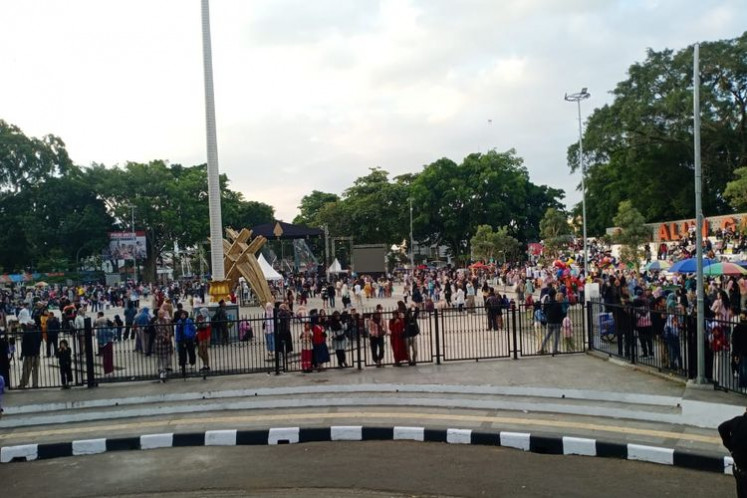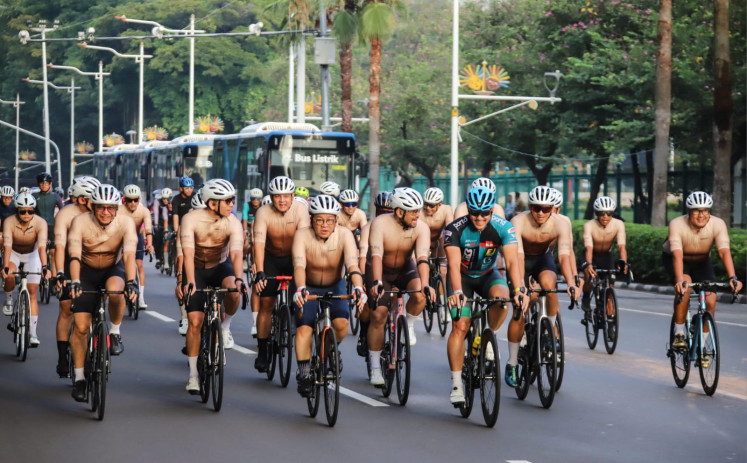Popular Reads
Top Results
Can't find what you're looking for?
View all search resultsPopular Reads
Top Results
Can't find what you're looking for?
View all search results‘Kebaya encim’, a story of the nation’s diversity
During this year’s commemoration of Independence Day at the State Palace, President Joko “Jokowi” Widodo, along with his ministers and guests, wore traditional attire to celebrate cultural diversity
Change text size
Gift Premium Articles
to Anyone
D
uring this year’s commemoration of Independence Day at the State Palace, President Joko “Jokowi” Widodo, along with his ministers and guests, wore traditional attire to celebrate cultural diversity. The required dress code was praised as a great reminder to all Indonesians of the spirit of Bhinneka Tunggal Ika (Unity in Diversity).
Several female guests and public figures were seen wearing kebaya encim, the kebaya distinct for its lace trimmings and embroidered flowers on cool, largely plain material, either white or other colors.
Kebaya encim or nyonya kebaya is part of Indonesian women traditional clothing with a long history of cultural assimilation between Indonesian, Dutch and Chinese descendants, often called Peranakan.
The history of kebaya encim can be traced to the early 20th century, known as the “golden age” of Peranakan Chinese life. Originally worn by Peranakan Chinese women, kebaya encim is now worn by all women, young and old, in any formal or informal event.
During the inauguration of police and military cadets at the palace, First Lady Iriana, the Vice President’s wife, Mufidah Kalla, the wife of the National Police chief, Tri Suswati, and the wife of the military commander, Nenny Nurmantyo, were seen dressed in light cobalt blue kebaya encim. It was among events showing, perhaps unwittingly, the successful assimilation of Peranakan Chinese culture, as part of our diversity.
As a product of cultural assimilation, kebaya encim is closely associated with the golden age of Peranakan Chinese, which historians date from 1842 to 1920. Peranakan Chinese were descendents of migrants from China to Southeast Asia during the 15th century during the rule of the Ming dynasty on the mainland. They settled in the Malacca Straits and Sumatra while retaining their traditions and adopting Indonesian culture.
The golden age of Peranakan Chinese started when the Dutch handed over Malacca to the British. Given the strategic location of the Malacca Straits, the British opened new industries such as rubber and tin mining, providing work opportunities for Peranakan Chinese. They began to acquire and accumulate wealth through property, furniture and clothes because tangible wealth was seen as a symbol of well-being in all aspects, including spiritual wealth.
Some sources suggest kebaya encim was a result of cultural exchange between Peranakan Chinese and the Javanese. While the Javanese kebaya uses silk or cotton and covers the knees, kebaya encim uses voile or lighter cotton, embroidered with lace at the edge of the torso.
Others suggest kebaya encim was first worn by Dutch women in the former East Indies as they were cooler for the climate, and later Peranakan Chinese adopted and modified them.
In 1910, the Dutch colonial government issued the Dutch Nationality Law to give equal privileges to the Peranakan Chinese, granting them equal status as Dutch nationals. Peranakan women started to adopt Dutch women clothing and modified them into more colorful kebaya and added embroidery.
The Dutch usually wore white kebaya encim, decorated with European lace to show luxury and higher status than local women also wearing kebaya. Since white in Chinese culture is associated with death and mourning, Peranakan Chinese adopted the kebaya in other colors and embroidered on them Chinese patterns such as lotus or dragons.
Kebaya encim served as a symbol of wealth and social status during the golden age of Peranakan Chinese in the straits. It was also seen as symbol of modernity and liberation, as the kebaya substituted their baju panjang, a long-sleeved tunic.
The golden age ended in 1940s following World War II, forcing them to abandon a lavish lifestyle. The wave of modernization also wiped away much of their culture.
Kebaya encim started to regain recognition in society following the rise of Indonesia’s fashion industry. In attempts to celebrate and revive traditional Indonesian clothing, designers have been creating and showcasing various classic and modern kebaya encim in fashion shows.
The attire is popular again, worn by any Indonesian women outside the Chinese community. It has even become among the most common type of kebaya as it can be worn daily, given the light cotton and adaptability, either worn with beautiful kain (cloth) of various ethnic origins, or even jeans.
As a result of cultural assimilation and adaptation into Indonesian women’s modern life, the story of kebaya encim reminds us to focus not on our differences but more on the positive results of our cultural diversity.
Cultural assimilation of the Peranakan Chinese, such as through clothing or their famed food, is an example that has led to a new, much richer Indonesian culture.
_______________________
The writer is a research assistant at the Centre for Strategic and International Studies (CSIS), Jakarta.










